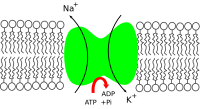
Photo from wikipedia
Introduction Phosphodiesterase-5a inhibition (PDE5i) leads to favorable changes in pulmonary hemodynamic and cardiac output (CO) in patients with advanced heart failure (HF) and reduced ejection fraction (HFrEF). The hemodynamic response… Click to show full abstract
Introduction Phosphodiesterase-5a inhibition (PDE5i) leads to favorable changes in pulmonary hemodynamic and cardiac output (CO) in patients with advanced heart failure (HF) and reduced ejection fraction (HFrEF). The hemodynamic response to PDE5i could be heterogeneous and the clinical variables associated with these changes are scarcely investigated. Materials and Methods Of 260 patients with advanced HFrEF referred for advanced therapies [cardiac transplant/left ventricular assist device (LVAD)], 55 had pulmonary hypertension (PH) and fulfilled the criteria for the PDE5i vasoreactivity test. Right heart catheterization (RHC) was performed as a part of clinical evaluation before and after 20-mg intravenous sildenafil. Absolute and relative changes in pulmonary vascular resistance (PVR) were evaluated to assess hemodynamic response to PDE5i. Clinical, biochemical, and hemodynamic factors associated with PVR changes were identified. Results Sildenafil administration reduced PVR (− 45.3%) and transpulmonary gradient (TPG; − 34.8%) and increased CO (+ 13.6%). Relative change analysis showed a negative moderate association between baseline plasma potassium and changes in PVR (r = − 0.48; p = 0.001) and TPG (r = − 0.43; p = 0.005) after PDE5i. Aldosterone concentration shows a direct moderate association with PVR changes after PDE5i. A significant moderate association was also demonstrated between CO improvement and the severity of mitral (r = 0.42; p = 0.002) and tricuspid (r = 0.39; p = 0.004) regurgitation. Conclusion We identified plasma potassium, plasma aldosterone level, and atrioventricular valve regurgitations as potential cofounders of hemodynamic response to acute administration of PDE5i. Whether modulation of potassium levels could enhance pulmonary vasoreactivity in advanced HFrEF deserves further research.
Journal Title: Frontiers in Cardiovascular Medicine
Year Published: 2022
Link to full text (if available)
Share on Social Media: Sign Up to like & get
recommendations!